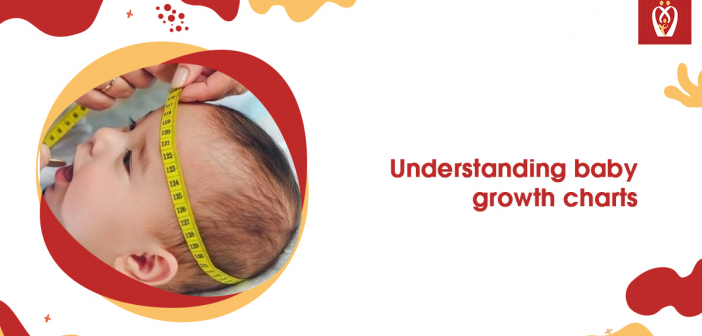Baby or infant growth charts indicate how your baby is growing. It is one way to ensure that the baby is developing typically. The growth chart usually shows the expected growth of the baby but don’t think of it as the last word and be concerned if your baby doesn’t fit the criteria. It doesn’t determine if the baby will be tall or short, skinny or healthy as an adult. Ensure you give your baby all the appropriate nutrients and keep them safe and healthy.
What is a baby growth chart?

As the name suggests, the growth chart helps you and your doctor track how your baby is growing. There are different charts for girls and boys, infants and older children, and it is different for everyone.
The growth chart records changes in the baby’s length, weight, and head circumference. These measurements are then marked down in the chart for you to see and understand the changes that happen over time with your baby. Every child has a personal chart where the doctor records the changes and measurements. (baby growth chart)
The vertical up and down axis shows the measurement, and the horizontal side-to-side axis shows the baby’s age.
Every child has a growth record chart in their personal child health record (P.H.C.R.) chart, often called a green, blue or red book, and it depends on the state you live in.
These charts show the pattern of growth healthy children usually follow, whether breastfed or having a mixture of both.
As there is a wide range of standards, don’t get hung up on your baby’s growth chart if there’s a slight change. All babies grow at their rate, and their measurements don’t mean if they will be tall or short, fat or skinny as an adult. The only important thing you need to remember as a parent is that your baby grows steadily and appropriately over time. (baby growth chart)
For your better understanding, this blog will help you learn more about baby growth charts.
Baby growth charts in the U.K. The growth charts used in the United Kingdom are based on WHO (World Health Organization). The growth charts standards are combined with the average baby weight and growth data gathered in the U.K. Your child’s growth charts need accurate plotting and interpretation, which requires skill and practice, and that is why it should only be done by your baby’s health care provider.
What do the centile lines mean?
You will see curved lines on the chart; those curved lines are called centile lines. Centile lines tell your baby’s average weight and height gain for different ages.
Often your baby’s weight and height may not follow a centile line; their measurements may go up and down by 1 centile line, but it is common for them to cross 2 centile lines. If this happens to your baby, talk to their health care provider. Also, it is normal for your baby to be on different centile lines for weight and height. (baby growth chart)
How do growth Percentiles work?
The higher the percentile number, the bigger your baby
will be compared to other babies of the same age. If your baby is in the 50th percentile, that means they fall right in the middle of the pack.
Growth charts for baby girls and boys | baby growth chart
Boys and girls have separate growth charts as boys, on average, are taller and heavier than girls, so their growth patterns are different. (baby growth chart)
The chart gives the measurement range between the 3rd and 97th percentile of the WHO growth standards for baby girls and boys. Checking through the growth chart can reassure you whether your baby girl and baby boy fits within the normal range of height, weight, and head circumference measurements for her age. (baby growth chart)
To track whether your baby is growing adequately and normally, you need to use a chart that shows her and his growth curve and percentile.
Your Baby’s weight gain |baby growth chart


Your baby will gain weight most rapidly in the first 6 to 9 months. The growth rate will slow once they become toddlers and are more active.
If your baby or toddler is ill, their weight gain might slow down. It will usually return to normal after 2 to 3 weeks.
Once your toddler is two years old, their height indicates how tall they will get, and if you want, you can also use the adult height predictor in their baby’s red book to work it out.
Your child’s health provider will check his or her weight and height to calculate their body mass index (B.M.I.) and plot it on a centile chart. This way, you will know if your child’s weight is in the normal range or not.
If your child is overweight or underweight, their health care provider will talk to you about their diet and what kind of physical activities they need.
How often should your baby be weighed?
After your baby is two weeks old, it should be weighed.
- No more than once a month up to 6 months of age
- No more than once every 2 months from 6 to 12 months of age
- No more than once every 3 months over the period of
You can also check their weight more than once if you are concerned about their growth.
Conclusion
Birth weight doesn’t determine anything about your baby’s future. Genes, not birth weight, determine your child’s adult size. Petite babies grow up to become the complete opposite, and large babies can become slender over the years. Ensure that your baby is getting proper nutrients and is eating healthily. Make sure they are active and engage them in physical activities like running and playing on the ground.
How Nurturey can help you?
The PinkBook by Nurturey is a digital substitute for N.H.S. Redbook. The PinkBook allows pregnant women and parents to access their child’s health records, view upcoming health checkups, and access trusted N.H.S. information about pregnancy and parenting. PinkBook will let you ease into your pregnancy and parenting journey. You can also schedule your appointments with G.P./midwife through the Nurturey PinkBook App. You can also communicate with your doctor about anything concerning or troubling you regarding your pregnancy and post-pregnancy. You can also get your prescription refills from your doctor. For more information, visit Nuturey at https://www.nurturey.com. You can download their App from the Google play store and Apple store.







